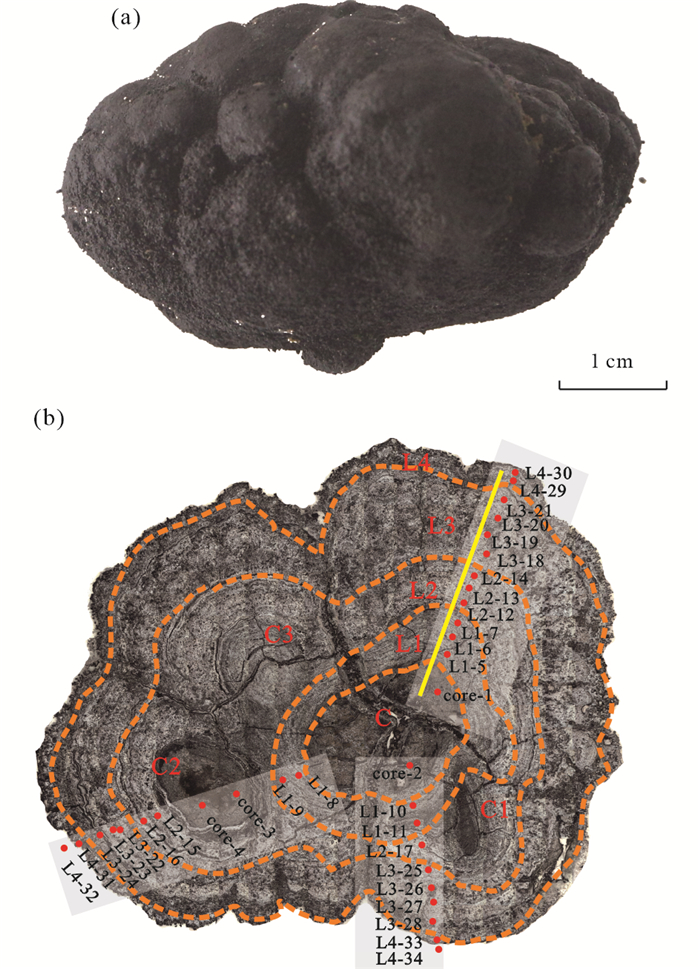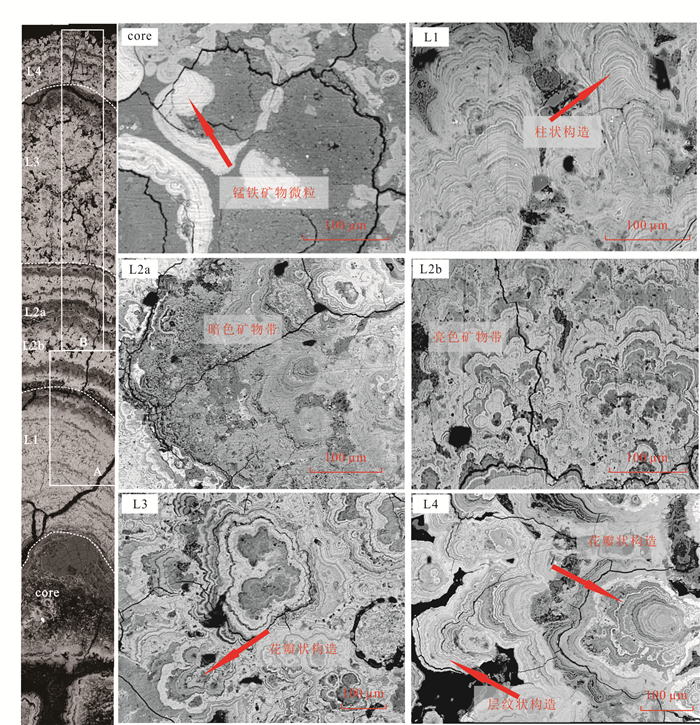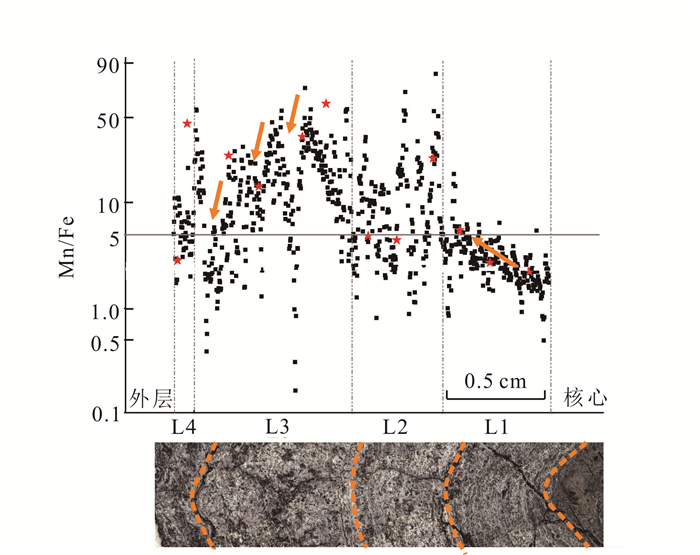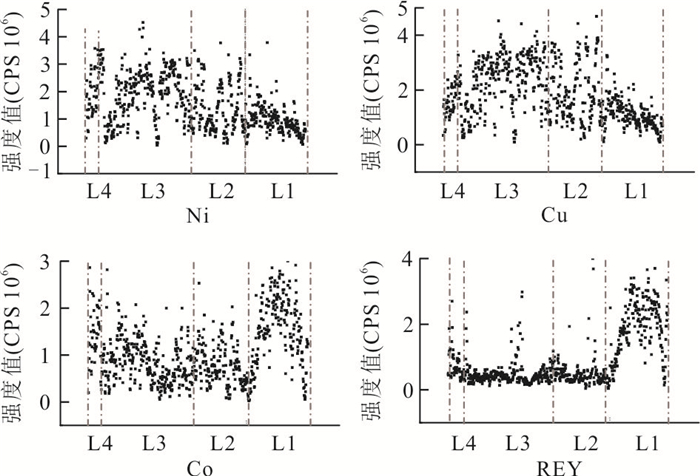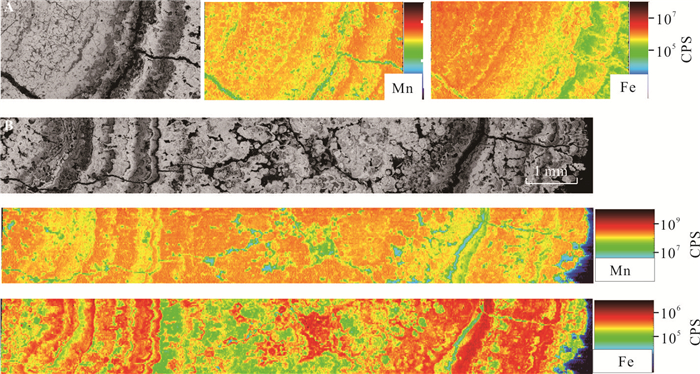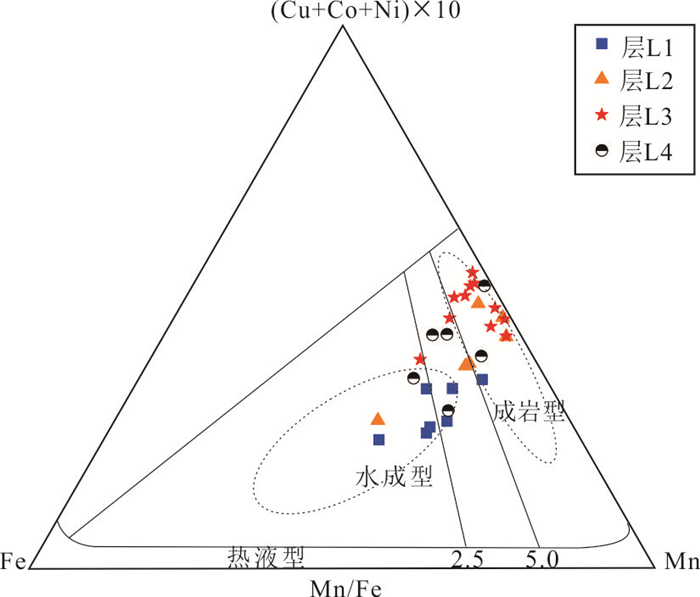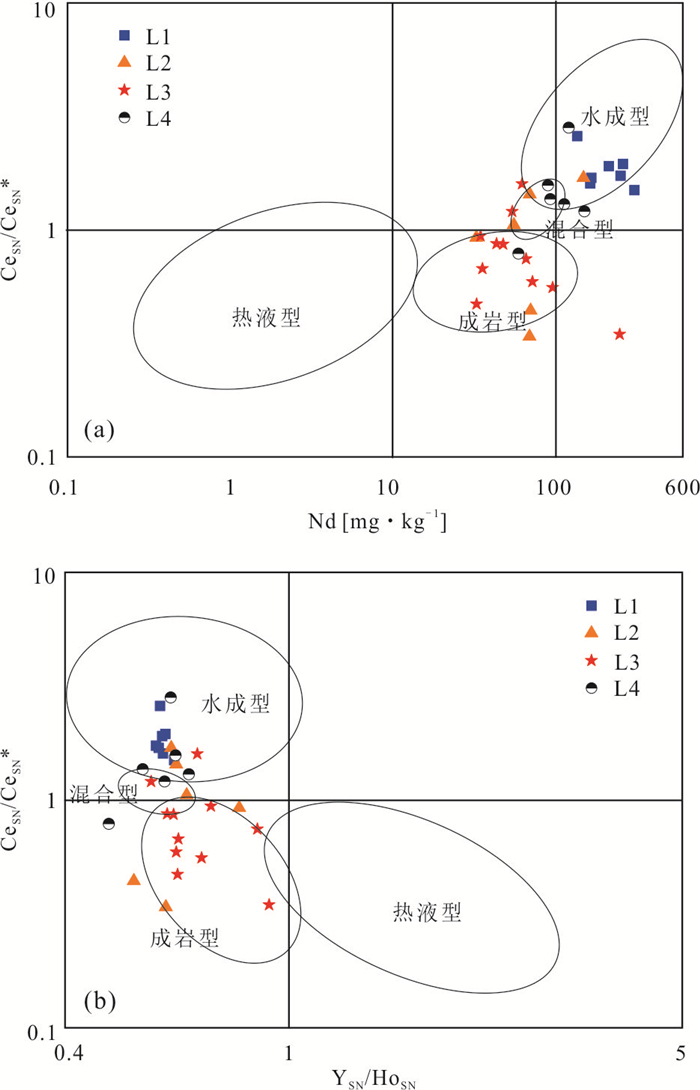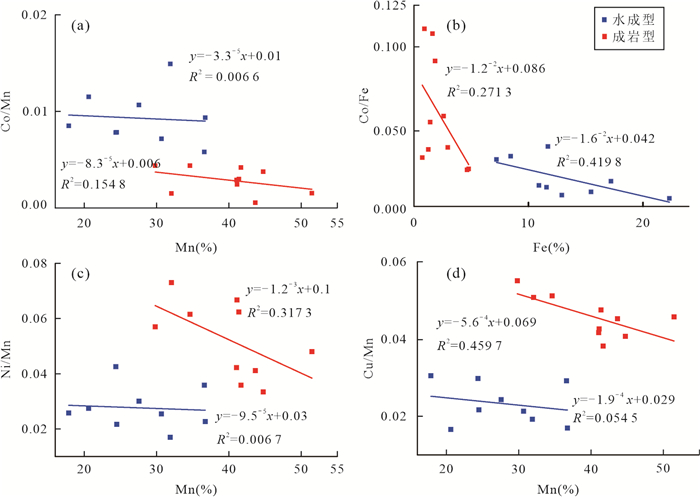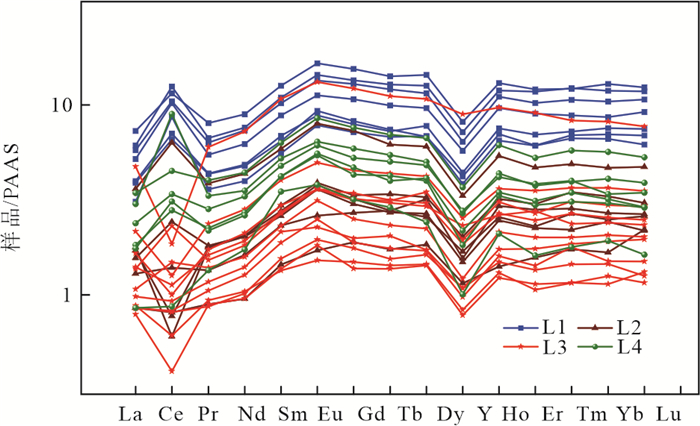|
Bau, M., Koschinsky, A., Dulski, P., et al., 1996. Comparison of the Partitioning Behaviours of Yttrium, Rare Earth Elements, and Titanium between Hydrogenetic Marine Ferromanganese Crusts and Seawater. Geochimica et Cosmochimica Acta, 60(10): 1709-1725. https://doi.org/10.1016/0016-7037(96)00063-4 |
|
Benites, M., Millo, C., Hein, J., et al., 2018. Integrated Geochemical and Morphological Data Provide Insights into the Genesis of Ferromanganese Nodules. Minerals, 8(11): 488. https://doi.org/10.3390/min8110488 |
|
Bodei, S., Manceau, A., Geoffroy, N., et al., 2007. Formation of Todorokite from Vernadite in Ni-Rich Hemipelagic Sediments. Geochimica et Cosmochimica Acta, 71(23): 5698-5716. https://doi.org/10.1016/j.gca.2007.07.020 |
|
Burns, R. G., Fuerstenau, D. W., 1966. Electron-Probe Determination of Inter-Element Relationships in Manganese Nodules. American Mineralogist, 51: 895-902 |
|
Burns, R. G, 1976. The Uptake of Cobalt into Ferromanganese Nodules, Soils, and Synthetic Manganese (IV) Oxides. Geochimica et Cosmochimica Acta, 40(1): 95-102. https://doi.org/10.1016/0016-7037(76)90197-6 |
|
Calvert, S. E., Price, N. B, 1977. Geochemical Variation in Ferromanganese Nodules and Associated Sediments from the Pacific Ocean. Marine Chemistry, 5(1): 43-74. https://doi.org/10.1016/0304-4203(77)90014-7 |
|
Deng, Y.N., Ren, J.B., Guo, Q.J., et al., 2019. Trace Elements Geochemistry Characteristics of Seawater and Porewater in Deep-Water Basin, Western Pacific. Earth Science, 44(9): 3101-3114(in Chinese with English abstract). |
|
Dimitrova, D., Milakovska, Z., Peytcheva, I., et al., 2014. Trace Element and REY Composition of Polymetallic Nodules from the Eastern Clarion-Clipperton Zone Determined by In-Situ LA-ICP-MS Analysis. Comptes Rendus Del Académie Bulgare Des Sciences: Sciences Mathématiques et Naturelles, 67(2): 267-274. |
|
Dominik, Z., Ukasz, M., Kotliński, R. A., et al., 2018. Geochemistry of Cobalt-Rich Ferromanganese Crusts from the Perth Abyssal Plain (E Indian Ocean). Ore Geology Reviews, 101: 520-531. https://doi.org/10.1016/j.oregeorev.2018.08.004 |
|
Dymond, J., Lyle, M., Finney, B., et al., 1984. Ferromanganese Nodules from MANOP Sites H, S, and R-Control of Mineralogical and Chemical Composition by Multiple Accretionary Processes. Geochimica et Cosmochimica Acta, 48(5): 931-949. https://doi.org/10.1016/0016-7037(84)90186-8 |
|
Guan, Y., Sun, X. M., Shi, G. Y., et al., 2017. Rare Earth Elements Composition and Constraint on the Genesis of the Polymetallic Crusts and Nodules in the South China Sea. Acta Geologica Sinica-English Edition, 91(5): 1751-1766. https://doi.org/10.1111/1755-6724.13409 |
|
Guan, Y., Ren, Y. Z., Sun, X. M., et al., 2019. Fine Scale Study of Major and Trace Elements in the Fe-Mn Nodules from the South China Sea and Their Metallogenic Constraints. Marine Geology, 416: 105978. https://doi.org/10.1016/j.margeo.2019.105978 |
|
Han, C.F., Yao, D., Xu, D. Y, 1994. Growth History of Manganese Nodules in Central Pacific Ocean. Marine Geology & Quaternary Geology, 14(4): 33-41 (in Chinese with English abstract). |
|
He, G.W., Sun, X.M., Yang, S.X., et al., 2011. A Comparison of REE Geochemistry between Polymetallic Nodules and Cobalt-Rich Crusts in the Pacific Ocean. Geology in China, 38(2): 462-472(in Chinese with English abstract). |
|
Hein, J. R., Mizell, K., Koschinsky, A., et al., 2013. Deep-Ocean Mineral Deposits as a Source of Critical Metals for High-and Green-Technology Applications: Comparison with Land-Based Resources. Ore Geology Reviews, 51: 1-14. https://doi.org/10.1016/j.oregeorev.2012.12.001 |
|
Hein, J. R., Koschinsky, A., 2014. Deep-Ocean Ferromanganese Crusts and Nodules. Treatise on Geochemistry. Amsterdam: Elsevier, 2014: 273-291. https://doi.org/10.1016/b978-0-08-095975-7.01111-6 |
|
Jiang, X. J., Lin, X. H., Yao, D., et al., 2010. Enrichment Mechanisms of Rare Earth Elements in Marine Hydrogenic Ferromanganese Crusts. Science China Earth Sciences, 54(2): 197-203. https://doi.org/10.1007/s11430-010-4070-4 |
|
Koschinsky, A., Halbach, P, 1995. Sequential Leaching of Marine Ferromanganese Precipitates: Genetic Implications. Geochimica et Cosmochimica Acta, 59(24): 5113-5132. https://doi.org/10.1016/0016-7037(95)00358-4 |
|
Lei, G. B., Bostrom, K, 1995. Mineralogical Control on Transition Metal Distributions in Marine Manganese Nodules. Marine Geology, 123(3/4): 253-261. https://doi.org/10.1016/0025-3227(95)00022-Q |
|
Lei, G. B, 1996. Crystal Structures and Metal Uptake Capacity of 10-Manganates: an Overview. Marine Geology, 133(1/2): 103-112. https://doi.org/10.1016/0025-3227(96)00010-2 |
|
Li, D. F., Fu, Y., Liu, Q. F., et al., 2020a. High-Resolution LA-ICP-MS Mapping of Deep-Sea Polymetallic Micronodules and Its Implications on Element Mobility. Gondwana Research, 81: 461-474. https://doi.org/10.1016/j.gr.2019.12.009 |
|
Li, D. F., Fu, Y., Sun, X. M., et al., 2020b. Critical Metal Enrichment Mechanism of Deep-Sea Hydrogenetic Nodules: Insights from Mineralogy and Element Mobility. Ore Geology Reviews, 118: 103371. https://doi.org/10.1016/j.oregeorev.2020.103371 |
|
Liu, J. H., 1992. Geochemistry of REE of Deep Sea Sediments in the Eastern Pacific Ocean. Marine Geology & Quaternary Geology, 12(2): 35-44(in Chinese with English abstract). |
|
Manheim, F. T., Lane-Bostwick, C. M, 1988. Cobalt in Ferromanganese Crusts as a Monitor of Hydrothermal Discharge on the Pacific Sea Floor. Nature, 335(6185): 59-62. https://doi.org/10.1038/335059a0 |
|
Manceau, A., Lanson, M., Takahashi, Y., 2014. Mineralogy and Crystal Chemistry of Mn, Fe, Co, Ni, and Cu in a Deep-Sea Pacific Polymetallic Nodule. American Mineralogist, 99(10): 2068-2083. https://doi.org/10.2138/am-2014-4742 |
|
Menendez, A., James, R. H., Lichtschlag, A., et al., 2019. Controls on the Chemical Composition of Ferromanganese Nodules in the Clarion-Clipperton Fracture Zone, Eastern Equatorial Pacific. Marine Geology, 409: 1-14. https://doi.org/10.1016/j.margeo.2018.12.004 |
|
Piper, D. Z, 1974. Rare Earth Elements in Ferromanganese Nodules and other Marine Phases. Geochimica et Cosmochimica Acta, 38(7): 1007-1022. https://doi.org/10.1016/0016-7037(74)90002-7 |
|
Radziejewska, T., 2014. Characteristics of the Sub-Equatorial North-Eastern Pacific Ocean's Abyss, with a Particular Reference to the Clarion-Clipperton Fracture Zone. Meiobenthos in the Sub-Equatorial Pacific Abyss, 15: 1-12. https://doi.org/10.1007/978-3-642-41458-9_2 |
|
Ren, J.B., Deng, X.G., Deng, Y.N., et al., 2019. Rare Earth Element Characteristics and Its Geological Implications for Seawater from Cobalt-Rich Ferromanganese Crust Exploration Contract Area of China. Earth Science, 44(10): 3529-3540(in Chinese with English abstract). |
|
Reykhard, L. Y., Shulga, N. A, 2019. Fe-Mn Nodule Morphotypes from the NE Clarion-Clipperton Fracture Zone, Pacific Ocean: Comparison of Mineralogy, Geochemistry and Genesis. Ore Geology Reviews, 110: 102933. https://doi.org/10.1016/j.oregeorev.2019.102933 |
|
Skornyakova, N. S., Murdmaa, I. O, 1992. Local Variations in Distribution and Composition of Ferromanganese Nodules in the Clarion-Clipperton Nodule Province. Marine Geology, 103(1/2/3): 381-405. https://doi.org/10.1016/0025-3227(92)90028-G |
|
Takahashi, Y., Manceau, A., Geoffroy, N., et al., 2007. Chemical and Structural Control of the Partitioning of Co, Ce, and Pb in Marine Ferromanganese Oxides. Geochimica et Cosmochimica Acta, 71(4): 984-1008. https://doi.org/10.1016/j.gca.2006.11.016 |
|
Usui, A, 1979. Nickel and Copper Accumplation as Essential Elements in 10-Å Manganite of Deep-Sea Manganese Nodules. Nature, 279(5712): 411-413. https://doi.org/10.1038/279411a0 |
|
Wegorzewski, A. V., Kuhn, T, 2014. The Influence of Suboxic Diagenesis on the Formation of Manganese Nodules in the Clarion Clipperton Nodule Belt of the Pacific Ocean. Marine Geology, 357: 123-138. https://doi.org/10.1016/j.margeo.2014.07.004 |
|
Wegorzewski, A. V., Kuhn, T., Dohrmann, R., et al., 2015. Mineralogical Characterization of Individual Growth Structures of Mn-Nodules with Different Ni+Cu Content from the Central Pacific Ocean. American Mineralogist, 100(11/12): 2497-2508. https://doi.org/10.2138/am-2015-5122 |
|
Zhang, H.S., Zhao, P.D., Hu, G. D, 2004. Geochemical Features of Multi-Metallic Crust in the Middle Pacific Ocean. Earth Science, 29(3): 340-346(in Chinese with English abstract). |
|
Zhang, Z. G., Du, Y. S., Wu, C. H., et al., 2013. Growth of a Polymetallic Nodule from the Northwestern Continental Margin of the South China Sea and Its Response to Changes in the Paleoceanographical Environment of the Late Cenozoic. Science China Earth Sciences, 56(3): 453-463. https://doi.org/10.1007/s11430-012-4535-8. |
|
Zhang, Z. G., Fang, N. Q., Du, Y. S., et al., 2009. Geochemical Characteristics and Their Causative Mechanism of Polymetallic Nodules from the Northwest Continental Margin of the South China. Earth Science, 34(6) 955-962(in Chinese with English abstract). |
|
Zhao, G.T., He, Y.Y., Chen, C., et al., 2011. Comparison of the Mineral and Geochemistry Characteristics between Co-Rich Crusts and Ferromanganese Nodules from the Pacific Ocean. Periodical of Ocean University of China, 41(5): 85-93 (in Chinese with English abstract). |
|
邓义楠, 任江波, 郭庆军, 等, 2019. 西太平洋深水盆地海水及孔隙水的微量元素地球化学特征. 地球科学, 44(9): 3101-3114. doi: 10.3799/dqkx.2017.562 |
|
韩昌甫, 姚德, 许东禹, 1994. 多金属结核的生长历史. 海洋地质与第四纪地质, 14(4): 33-41. |
|
何高文, 孙晓明, 杨胜雄, 等, 2011. 太平洋多金属结核和富钴结壳稀土元素地球化学对比及其地质意义. 中国地质, 38(2): 462-472. doi: 10.3969/j.issn.1000-3657.2011.02.020 |
|
姜学钧, 林学辉, 姚德, 等, 2011. 稀土元素在水成型海洋铁锰结壳中的富集特征及机制. 中国科学: 地球科学, 41(2): 197-204. doi: 10.3969/j.issn.1000-3045.2011.02.013 |
|
刘季花, 1992. 太平洋东部深海沉积物稀土元素地球化学. 海洋地质与第四纪地质, 12(2): 35-44. |
|
任江波, 邓希光, 邓义楠, 等, 2019. 中国富钴结壳合同区海水的稀土元素特征及其意义. 地球科学. 44(10): 3529. doi: 10.3799/dqkx.2018.258 |
|
张振国, 方念乔, 杜远生, 等, 2009. 南海西北陆缘多金属结核地球化学特征及成因. 地球科学, 34(6): 955-962. doi: 10.3321/j.issn:1000-2383.2009.06.010 |
|
赵广涛, 何雨旸, 陈淳, 等, 2011. 太平洋铁锰结核与富Co结壳的矿物地球化学比较研究. 中国海洋大学学报(自然科学版), 41(5): 85-93. |










 下载:
下载:
